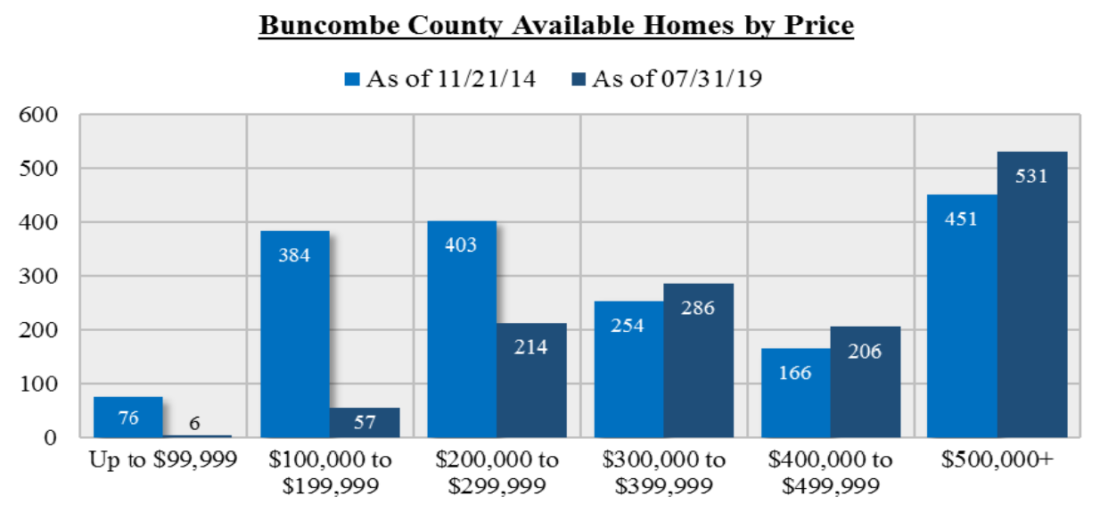The number of houses available for under $200,000 in Buncombe County, as of this July? 63.
Down from 460 homes in November 2014, that figure is just one of the troubling data points from the most recent edition of the Bowen Report, a city of Asheville-commissioned study conducted by Bowen National Research that has provided periodic updates on affordable housing since February 2015.
The report, publicly released on Oct. 3, suggests that pent-up demand, relatively low resident incomes and “skyrocketing” rents will keep housing affordability problematic for Buncombe County owners and renters alike.
Since 2014, median rental costs have increased at a 5.4% annual rate. A $1,000 monthly rent in 2014 following that trend, for example, would now be $1,300. Although market-rate rental vacancies have increased from 1.2% to 6% over the same period, that increase in supply has not limited rent hikes.
According to the report, approximately 2,781 Housing Choice Voucher holders live within the Housing Authority of the City of Asheville’s jurisdiction, with 1,442 people currently on a waiting list for additional vouchers. “These market metrics indicate a strong level of pent-up demand for rental housing serving the lowest income households in the market,” Bowen notes.
Due to this limited number of affordable options, many renters have resigned themselves to cost-burdened housing situations. Nearly 18,000 renter households in Buncombe County pay “disproportionately high shares of their income towards housing costs,” reports Bowen.
Of those residents, 46.1% pay more than 30% of their income toward housing, while 19.4% of renters pay over 50%. Moreover, upward of 3,500 households live in substandard conditions, defined by Bowen as “overcrowded or lacking complete indoor plumbing.”
Scarcity also persists for those looking to make the jump from renting to homeownership. Bowen points out that the current median home sales price is $315,000, a 10-year high; as of July, only 277 homes under $300,000 were available for sale. And with Buncombe County anticipated to experience population growth of 17,899 (6.7%) between 2018 and 2023, the report says, “this rapid growth will continue to contribute to the ongoing demand for housing for the foreseeable future.”
“More and more folks are getting pushed out of homeownership,” said Paul D’Angelo, Asheville’s community development program director, at an Oct. 3 meeting of the city’s Affordable Housing Advisory Committee. “If wages keep remaining stagnant and prices keep going up, we’re pushing more people into rental and giving less people the ability to gain wealth. I have to say, it’s a real concern.”
Despite these challenges, D’Angelo told Xpress there are a few bright spots in the report. For example, he said, 368 (15.1%) of the 2,441 units within the county’s existing or in-development mixed-income projects are reserved for households earning up to 80% of the area median household income, or $53,120.
The occupancy rate for all multifamily rentals has also decreased from 99.2% in 2014 to 95.3% as of this July. In combination with the 6% market-rate rental vacancy rate, D’Angelo suggested, that availability may lead to rent price stabilization. “That could work in favor of better affordability. It shows a little hope,” he said.
D’Angelo said that the city is working to involve the Asheville-Buncombe County Economic Development Coalition, Asheville Area Chamber of Commerce, Buncombe County Tourism Development Authority and other organizations with issues such as wage stagnation and economic development. Those concerns are not directly within the AHAC’s purview, he explained, but play a large role in affordability issues.
While the current data might not be reassuring, D’Angelo emphasized that the Bowen Report is critical to the city’s work on affordable housing. “It’s really important to get a snapshot in time about how things are going,” he said. “It does help influence our policies and shed light on issues that either reaffirm our hearing on the ground or reveal an interesting fact regarding vacancy rates and market-rate units.”



Before you comment
The comments section is here to provide a platform for civil dialogue on the issues we face together as a local community. Xpress is committed to offering this platform for all voices, but when the tone of the discussion gets nasty or strays off topic, we believe many people choose not to participate. Xpress editors are determined to moderate comments to ensure a constructive interchange is maintained. All comments judged not to be in keeping with the spirit of civil discourse will be removed and repeat violators will be banned. See here for our terms of service. Thank you for being part of this effort to promote respectful discussion.